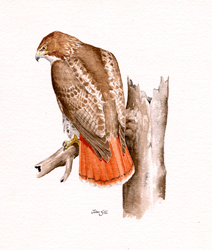Breeding Bird Atlases (BBA)
Find a Bird - BBA1
Breeding Bird Atlas 1 Species Accounts
Red-tailed Hawk
Buteo jamaicensis
Egg Dates
March 15 to May 6
Number of Broods
one; may re-lay if first attempt fails.

Nearly a century ago, Red-tailed Hawk populations diminished greatly in Massachusetts. This crash was well documented by Brewster (1906) and Griscom (1949) and was due largely to widespread shooting and trapping. Once protection was afforded to birds of prey, Red-tailed Hawks began to recover, and numbers of both residents and migrants climbed. During the late 1940s, populations in many parts of the range began another decline, due to the triple threat of continued direct persecution from people, habitat loss, and pesticides in the food chain.
During the Atlas period, the Red-tailed Hawk was distributed throughout the state and was confirmed in all counties. This species’ ability to adapt to a wide range of habitats has been a positive factor, and its preference for open areas with scattered trees and small woodlots allows it to nest in developed areas of eastern Massachusetts. On the map, concentrations of “confirmed” and “probable” breeding, even in suburbs or large cities, should be noted.
Red-tailed Hawks are masters of soaring, and, consequently, they make countless, slow, spiral circles in search of prey, in defense of territory, and during courtship. When courting, the birds sometimes dive and swoop at each other, or even grapple in midair with a grace that seemingly is impossible for so large a bird.
This hawk’s call, uttered from a perch as well as on the wing, is a hoarse descending scream. Once recognized, the sound will not be readily forgotten. Blue Jays can mimic the call well. Red-tailed Hawks hunt a variety of mammals, birds, reptiles, and other small animals from flight or a perch.
Migration in spring occurs early, beginning in March and continuing into May. Breeders from farther north pass through, but, as with other raptor species in New England, the spring flight is but a shadow of the autumn migration. Some pairs are year-round residents.
Most pairs in Massachusetts are on their breeding territories by March. Nests are generally placed in trees near the edge of a tract of mature forest. Massachusetts nests have been recorded in White Pine, Black Gum, American Beech, and several species of oaks (CNR, Olmstead). On Cape Cod and the Islands, Pitch Pines may be used. Some pairs show a preference for building in one particular type of tree (Olmstead). The height of 14 Massachusetts nests ranged from 35 to 80 feet, with an average of 53 feet. A nesting site, once selected, will tend to be used year after year, but pairs generally have more than one nest location in their territories. Frequently, a nest built by Red-tailed Hawks will be used in alternate years by the hawks and a pair of Great Horned Owls (Olmstead).
The very large nest, up to 2.5 to 3 feet in outside diameter, is built of sticks and twigs and is decorated regularly with green foliage. When placed in a deciduous tree, the nest is occupied before spring leaves appear. Typical clutches in our part of the continentwide range consist of one to three eggs. Incubation, which is carried out mostly by the female, lasts for 28 to 32 days. Re-laying may occur if the eggs are lost early in the cycle, but most pairs do not renest because they continue to incubate addled eggs far into the season, or they lose young chicks to inclement weather (Olmstead). The nestling period ranges from April to August, with most reports from May to July. Of 93 Massachusetts nests, 14 contained three nestlings, 38 had two nestlings, and 41 had one nestling (Olmstead).
Young birds remain on the nest for a long time, fledging when they are about 45 days old. They closely resemble the adults in size and plumage, except for the tail color. Juveniles can be observed until the end of August, accompanying their parents and giving a shrill food-begging call.
Fall migration runs late, beginning in September and continuing into December. Autumn flights at favored lookouts such as Mount Wachusett in Princeton often yield daily totals of 10 to 20 birds and can exceed 40 to 50. These counts are perhaps only a third as large as those recorded 30 years ago.
Red-tailed Hawks winter south to the Gulf of Mexico and beyond, but many individuals remain in the north, and some may be permanent residents. They occur statewide, and, in certain winters, especially those with little snow cover, rather high concentrations appear, particularly along the coast. At such times, the birds are found mainly adjacent to fields and roadsides, such as along interstate highways, especially at interchanges.
Map Legend and Data Summary
Atlas 1 data collected from 1975-1979


Note: fairly common in woodlands and farmlands throughout most of the state
Leif J. Robinson, Thomas Lipsky, and W. Roger Meservey



